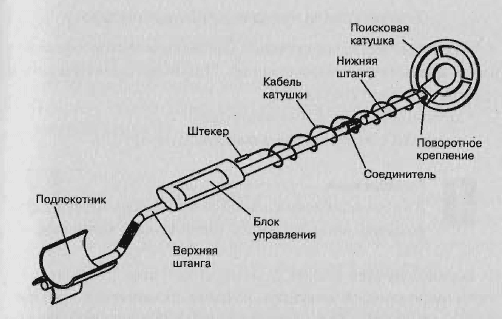The component parts of the metal detector

Fig. 1.1. The component parts of the metal detector
Armrest. He is at the top of the main rod and locks the elbow hands operator. Attached to the rod by means of bolts.
The main, upper rod. Usually it has a "S"-shaped profile, as shown in Fig. 1.1. On the bending of the core rod is placed spongy handle the operator holds the metal detector. To it is attached the armrest with the ability adjust the distance.
The ideal distance between the armrest and the handle should be the length of the brush operator. This provides ergonomics due to the better balance of the system, while the operator less fatigue.
A control unit. Contains electronic circuitry that allows you to generate and to process the signals from the search coil. Most often, the control unit is mounted on the main bar in the plug connection, but there are models that have the main rod and the control unit are a single entity.
The lower rod of reinforced plastic. On one side it is inserted in the main bar, where the fixed connector with a clamping ring. The use of this type the locking mechanism allows at any time to adjust the overall length of the device, choosing the most optimal for the operator.
The search coil. Fastened to the lower connecting rod using a plastic bolt and nuts. Turns out the connection with the possibility of adjusting the angle between the plane reel and rod. From the coil to the control unit there is a cable that has the connection plug and is connected to the connector.
Usually, when the search is complete, be incomplete disassembly of the detector for transportation purposes, into two parts:
- the lower rod with a coil;
- the upper rod with the control unit and armrest.
The configuration of the coils of the metal detector
Coils metaloiskateley (metal detectors) can have a different configuration. The most practical and technologically considered:
- coil with a "wide" grip;
- coil with point capture.
Currently, the most often used second design option with "point" grip.
In some cases, around the receive coil is wound a portion of the transmitting coil, which included anti - phase-main (large diameter). The number turns this anti-phase coils is chosen so that the field around the receive coil was balanced. A large magnetic flux transmitting coil entering from one side, balanced by the magnetic flux of the small coils included in the receiving coil on the other side.
There is a certain proportion in the ratio of the diameters of the transmitting and reception coils. When this is achieved the best configuration of the system, as well as the possibility of obtaining in the receiving coil of the small level of residual signal.
The level of the residual signal depends on many factors:
- from the signal transmitting coil;
- from the location of the coils;
- the number of turns of the receiving coil;
- from q;
- the quality of workmanship;
- from the shape of the coils;
- from their relative position.
Therefore, can have significant variation from units to hundreds of millivolts.
If the receiving coil included in the parallel resonant circuit (which is pretty often), the residual signal level may increase in tens and hundreds of times due to the resonance.
In this case, it is impossible to get significant pre-amp signal receive coil by an alternating voltage. This, in turn, requires significant gain DC voltage after the detection of the desired signal. But then exacerbated the problem of "drift", leading to unstable operation of the detector.
The level of the residual signal (O. S.) to some extent can affect the sensitivity of the detector. In fact, after the detection of the useful signal in the successor, the ratio signal/noise at high levels of O. S. is reduced.
Comparison of the properties of the coils with large and small widths
What is the coil's better to search with "wide" or "narrow" grip? Unambiguous the answer is no.
The experience of using targeted capture better, since the coil with wide capture:
- have low capacity point focus;
- have the tendency to take false signals from iron objects, which located on the outskirts of the search areas.
But "wide" coil not allow such dense scan we examine the plot of land as a coil with a "point" grip.
This allows for a fixed period of time to view large site and if the site is still not too saturated with the metal, it turns out decent time savings.
Working with a coil having a "point" capture, monitor the density scan. Each successive sweep of the coil should not be more than polumetra overlap the previous trajectory. Otherwise, omissions inevitable, especially to limit the depth of detection.
Coil with point capture have the advantages of:
- good at working on trashy sites;
- they are easier and faster to establish the exact place of occurrence of the finds (the target).
Few search engines follow the rules of working with coils having a "point" capture.
The trajectory of their coil resembles a wide zigzag on the sectors covered, the result is a lot of missed findings. In the end, during the follow-up "rung" of such plots were often missed their findings.
Be careful, do not rush, remember, only one missed your thing can be more valuable than all the rest put together.
Author: S. L. Dubrovsky






